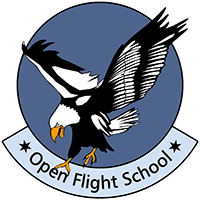OBOGS | ||
|---|---|---|
Onboard Oxygen Generation System Further information:
| ||
AMPCD | ||
|---|---|---|
Advanced Multipurpose Colour Display The AMPCD (hereinafter simply referred to as MPCD) is a multicoloured digital display that is suitable for night vision goggles and can display any format that can be selected using the menu, apart from the air-to-ground RADAR display. Source: <InstallDir>\Mods\aircraft\FA-18C\Doc\DCS FA-18C Early Access Guide EN.pdf Additional information:
| ||
PB | ||
|---|---|---|
PB's in the F/A-18C designate the buttons around the AMPCD and DDI's (20 each). The screens show the current options of the buttons next to the PB's. When pressed, the screen either switches to the specified page, or the activated option is framed to indicate that it is selected or active. If there is nothing next to the PB, it has no function at the moment. In our courses we name the buttons after their function. In other sources they are numbered consecutively (from the bottom left corner clockwise e.g: PB 19 is in the bottom row of the 2nd from the left). Further information: | ||
DSMS | ||
|---|---|---|
DSMS Digital Stores Management System | ||
LAI | ||
|---|---|---|
Lookout, Attitude, Instruments A method of maintaining a good Lookout whilst ensuring the aircraft maintain the desired altitude, heading and speed. LOOKOUT - This is completed in two stages, beginning with the Right hemisphere. Look as deep into your 5 o’clock as you can and scan fully up and down whilst progressing you Lookout back to the ahead. ATTITUDE - Whilst looking ahead assess you aircraft‘s attitude to the horizon. Ensure it remain where you desired. INSTRUMENTS - Check that this attitude is maintain your chosen flight path by checking the instruments:
See also: SHT for a method of correcting errors | ||
NAVEX | ||
|---|---|---|
Navigation Exercise A flight primarily aimed at exercising navigation skills | ||
HAT | ||
|---|---|---|
Heading, Altitude, Time A method of conducting a turn at a waypoint during navigation. This occurs twice, Before the turning point is the Pre-HAT and after the turning point is the Post-HAT Pre-HAT HEADING - Having seen the turning point (or planning to turn on time) Check the next heading from your navigation plan. Adjust this heading for drift using Max Drift and Clock Code. ALTITUDE - Check if there is a required change of altitude for the next leg and the associated Safety Altitude. TIME - If running individual leg timing, reset the clock. If running continuous timing for the route, note the time at the waypoint. At the waypoint, Restart the clock (if required), Lookout and Turn.... JUST Lookout and Turn until rolling out on heading. Do NOTHING else. Post-HAT HEADING - After rolling out, check you have rolled out on your wind adjusted heading. ALTITUDE - Adjust your altitude for the next leg. TIME - Ensure the clock is running or if you forgot to note the time at the waypoint take the time now and add a few second for the turn.
| ||
3 OFFs | ||
|---|---|---|
Bearing Off, Distance Off, Time Off A method of checking leg tracking and timing at the mid leg check point during navigation BEARING OFF - At your mid leg check point assess your location compared to the check point and estimate the difference in bearing from the start waypoint. DISTANCE OFF - Estimate the Distance Off of track using the 1 in 60 Rule. TIME OFF - Note hoe the time abeam the check point compares to the planned time From these three Offs the aircraft can be flown back onto track or flown directly to the end leg waypoint. Also an assessment of the time of arrival at the leg end waypoint can be made or the aircraft speed changed to maintain a time over the waypoint. | ||
Max Drift | ||
|---|---|---|
Max Drift A method of assessing the effect of wind on the aircraft drift from track. MAX DRIFT - The maximum drift an aircraft will suffer from a wind directly abeam the flight path. This is estimated by taking the windspeed and dividing it by the aircraft’s speed in nm / minute. E.g. An aircraft flying at 240 kts is covering 4 nm / minute. With a wind from directly abeam with a speed of 20 kts the aircraft will suffer a drift of 5˚. 20 / 4 = 5 See also: Clock Code | ||
Clock Code | ||
|---|---|---|
Clock Code This has two meanings depending upon its application. Lookout - When applied to Lookout, Clock Code is a method of identifying an azimuth direction from the aircraft. Directions from the aircraft begin from 12 O’clock being directly ahead with 6 O’clock being directly astern. E.g. 4 O’clock indicates a direction past the abeam on the right side of the aircraft. Drift - When applied to Drift, Clock Code is a method of mental arithmetic to estimate the Sin() function. The difference between the wind direction and the aircraft‘s flight path is compared to minutes of a clock. The resulting potion of the hour is the portion of Max Drift to be used to estimate the angular correction to make to offset the aircraft‘s heading and so allow for drift, thus keeping the aircraft on track. E.g. 30˚ implies 30 minutes which is half an hour and so half the Max Drift should be applied towards the wind for the aircraft to maintain the desired track. | ||
Bingo | ||
|---|---|---|
Bingo Fuel The fuel required to fly directly back to base in a straight line. | ||
Chicken | ||
|---|---|---|
Chicken Fuel The minimum fuel required to continue the route as planned. | ||
Ramp | ||
|---|---|---|
Ramp Fuel The minimum fuel required to be in the airbase overhead prior to landing, or on deck if landing on a vessel. | ||
